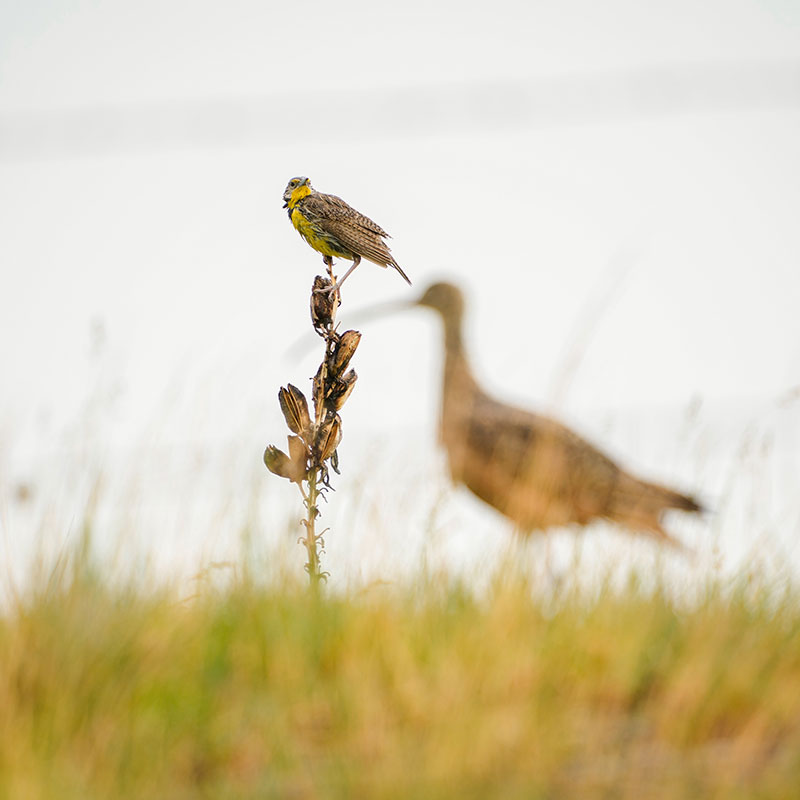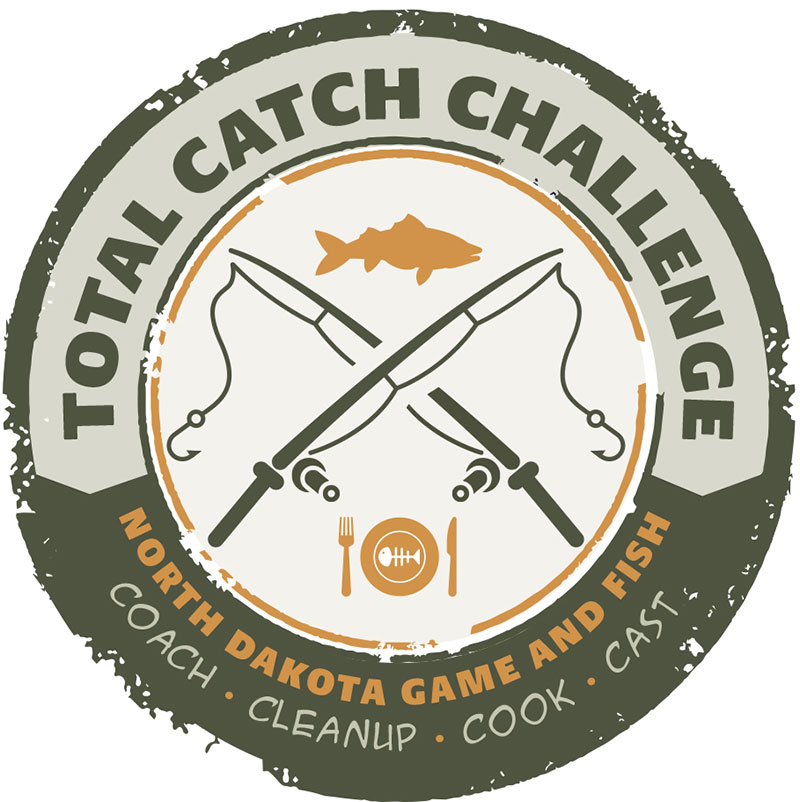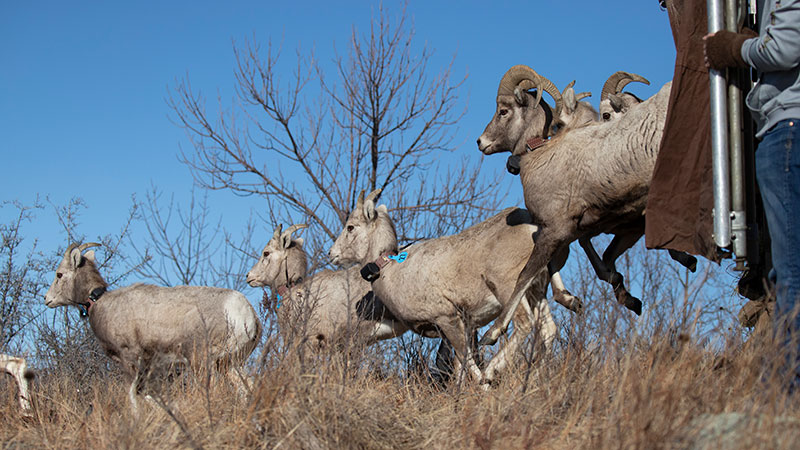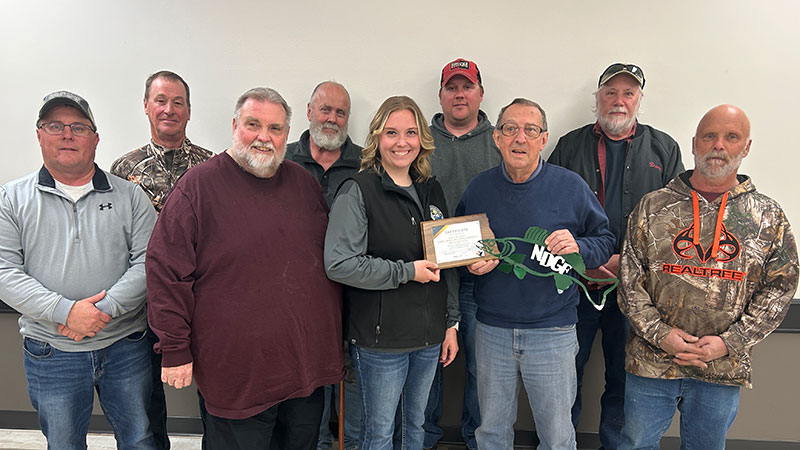
Buffaloberry Patch
2024 Deer Season Summarized
A total of 42,416 North Dakota deer hunters took approximately 23,300 deer during the 2024 deer gun hunting season, according to a post-season survey conducted by the state Game and Fish Department.
Game and Fish made available 50,100 deer gun licenses last year. Overall hunter success was 55%, with each hunter spending an average of 4.7 days in the field.
Hunter success for antlered white-tailed deer was 49% and 44% for antlerless whitetails.
Mule deer buck success was 80% and 78% for antlerless mule deer.
Hunters with any antlered or any antlerless licenses generally harvest white-tailed deer, as these licenses are predominantly in units with mostly whitetails. Buck hunters had a success rate of 61%, while doe hunters had a success rate of 56%.
Game and Fish issued 11,920 gratis licenses in 2024, and 9,484 hunters harvested 4,199 deer for a success rate of 44%.
A total of 956 muzzleloader licenses were issued, and 790 hunters harvested 232 white-tailed deer (116 antlered, 116 antlerless). Hunter success was 29%.
A total of 27,102 archery licenses (23,993 resident, 3,109 nonresident) were issued in 2024. In total, 22,449 bowhunters harvested 5,794 deer (4,884 whitetails, 910 mule deer) for a success rate of 26%.
In addition to harvest rates and winter aerial surveys, Game and Fish staff monitor other population indices to determine license numbers, including depredation reports, hunter observations, input at advisory board meetings, and comments from the public, landowners and Department field staff.
Tracking Grassland Birds
2024 Harvests Stats for Big 3
Harvest statistics released by the North Dakota Game and Fish Department show overall hunter success during the 2024 season was 100% for bighorn sheep, 92% for moose and 64% for elk.
The Department issued six bighorn sheep licenses and auctioned one. All seven hunters harvested a bighorn ram.
The Department issued 238 moose licenses last year. Of that total, 229 hunters harvested 210 animals – 125 bulls and 85 cows/calves. Harvest for each unit follows:
| Unit | Hunters | Bulls | Cow/Calf | Success Rate |
|---|---|---|---|---|
| M5 | 8 | 5 | 0 | 63 |
| M6 | 10 | 9 | 1 | 100 |
| M8 | 15 | 13 | 1 | 93 |
| M9 | 76 | 33 | 36 | 91 |
| M10 | 78 | 43 | 31 | 95 |
| M11 | 42 | 22 | 16 | 91 |
The Department issued 905 elk licenses last year. Of that total, 817 hunters harvested 526 elk – 220 bulls and 306 cows/calves. Harvest for each unit follows:
| Unit | Hunters | Bulls | Cow/Calf | Success Rate |
|---|---|---|---|---|
| E1E | 147 | 38 | 36 | 50 |
| E1W | 198 | 42 | 91 | 67 |
| E2 | 149 | 37 | 60 | 65 |
| E3 | 285 | 80 | 114 | 68 |
| E4 | 24 | 19 | 1 | 83 |
| E6 | 14 | 4 | 4 | 57 |
Fish Challenge Underway
Anglers are once again invited to participate in the North Dakota Fish Challenge. The challenges, which started in 2022, encourage exploration of North Dakota’s many fisheries, and this year, promote active stewardship of the resource.
Gratis Application Process Improved
North Dakota landowners applying for deer gratis licenses will notice improvements to the online application process.
The new system simplifies land selection by allowing users to click on property descriptions rather than manually entering lengthy details.
During the first year, applicants need to search and select their lands. In subsequent years, a convenient renewal button will speed up future applications. An additional link is available to reference previous years records.
These changes help validate eligible records more efficiently, ultimately reducing the time required to process the deer lottery. By improving accuracy and preventing errors, the system ensures a smoother experience for applicants and a timely lottery for those eager to receive their results.
Step-by-step guidance is available online.
General deer and muzzleloader lottery applications will be online in early May. The deadline to apply is June 4.
Bighorn Sheep Population Stable
Earth Day Patch Contest Winners
The North Dakota Game and Fish Department announced the winners of the 2025 Earth Day Patch Contest. Over 1,600 students from 100 schools entered this year’s contest.
Winners in four age categories are Tryg Klindworth, Beulah (K-3); Mariah Achtenberg, White Shield (4-6); Jazmin Vasquez, Minot Bishop Ryan (7-9), and Brielle Volk, Mohall (10-12). Achtenberg’s design was chosen as the overall winner and will be made into the 2025 Earth Day patch.
Youth and adults who participate in cleaning up public lands receive the 2025 patch to celebrate Earth Day and their service. Projects that qualify for the Earth Day patch include refuse pick-up on local, state or federal properties and landscaping on public property including planting trees, bushes and pollinator plants.
Groups participating in the service projects are encouraged to take the following precautions to ensure their safety: keep young people away from highways, lakes and rivers and only allow older participants to pick up broken glass or sharp objects.
Participants are asked to contact Sherry Niesar at 701-527-3714 to receive a patch.
Summer Workshop for Educators
The North Dakota Game and Fish Department is sponsoring Pollinators in the Classroom, a professional development workshop for educators.
Pollinators in the Classroom will be held June 10-11 at United Tribes Technical College in Bismarck. The workshop will explore pollinators, what they are, where they live, life cycles, importance, and how you can make a difference. It will be fun and fast paced with many hands-on activities educators can use in their classrooms and incorporate discussion of classroom and curriculum integration.
Students will receive a copy of the Urban Pollinator Program Curriculum and should be prepared for walking field trips in the area. All materials are included.
The course is suitable for K-12 educators.
For more information contact curriculum specialist Sherry Niesar at 701-527-3714.
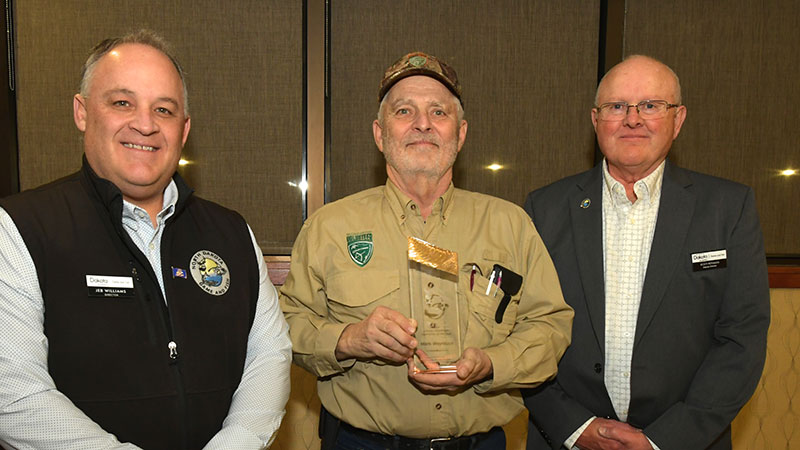
From left: Jeb Williams, Department director, Mark Weyrauch, Hunter Education Instructor of the Year, and Scott Peterson, Department deputy director.
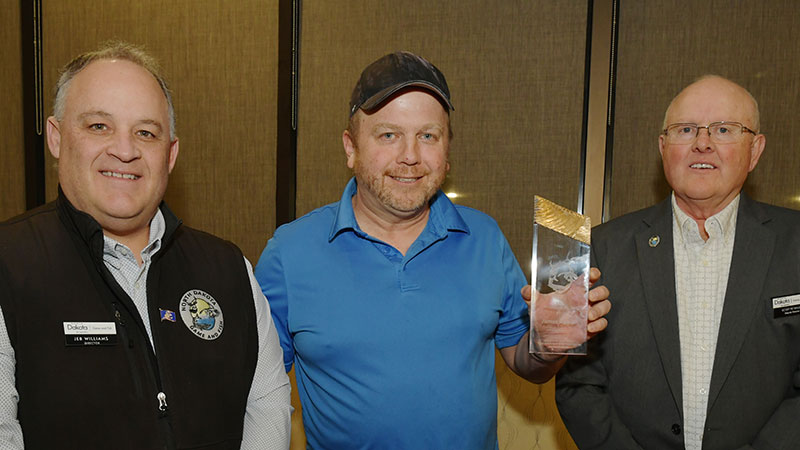
From left: Jeb Williams, Department director, James Decker, Volunteer of the Year, and Scott Peterson, Department deputy director.

From left: Jeb Williams, Department director, Cody Hirschfeld, one of the members of the Hunter Education Team of the Year, and Scott Peterson, Department deputy director.
Agency Volunteers Recognized
Volunteer instructors for the North Dakota Game and Fish Department were recently recognized at the annual banquet in Bismarck.
Mark Weyrauch, Ray, was recognized as Hunter Education Instructor of the Year, while the Hunter Education Team of the Year honor went to Cody Hirschfeld and Kenny Dvorak, both of Dickinson. James Decker, Bismarck, was awarded the Volunteer of the Year award.
Longtime volunteers were also recognized for their service:
30 Years – Clinton Baxter, Minot; Kevin Bishop, Kathryn; Roger Dienert, Hankinson; Karla Meikle, Bismarck; Gregory Odden, Rugby; Rick Olson, Garrison; Brad Pierce, Hatton; and Mark Weyrauch, Ray.
25 Years – Adnan Aldayel, New Rockford; Lynn Baltrusch, Fessenden; Stanley Cox, Jamestown; Don Ferguson, Jamestown; Donn Hancock, Emerado; Doyle Johannes, Underwood; Mitchell Kallias, Minot; Gary Knotts, Fargo; Rodney Parrill, Bottineau; Richard Petersen, Bismarck; Pam Podell, Velva; and Rickie Theurer, Mandan.
20 Years – Nathan Fitzgerald, Sterling, Colo.; Walter Helfrich, Lincoln; Michael Melaas, Minot; Dustin Neva, Hatton; Jean Oster, Lisbon; Joseph Schirado, Bismarck; Dallas Schmidt, Velva; Dan Spellerberg, Wahpeton; and Gary Wilz, Killdeer.
15 Years – Mathew Deal, Sutton; Jason Heinz, Rolette; Petrina Krenzel, Harvey; Richard Lehmann, Towner; Kellen Leier, Bismarck; and Corey Wysocki, Grafton.
10 Years – Kendall Bauer, Bismarck; Justin Campbell, Hannaford; Alan Haut, Fargo; Joe Beaufort, New Town; Joel Johnson, Mooreton; Shannon Johnson, Fargo; Leah Vantilborg, Mandan; and Priscilla Sauer, Glen Ullin.
5 Years – Bryton Allard, Williston; Dave Broadwell, Valley City; Cory Geiszler, Rugby; Nicholas Gustafson, Stanley; Daniel Hamman, Fairmount; Karna Johnson, Fargo; Brandon Laddusaw, Wyndmere; Samantha Mahn, Kulm; John Mazur, Pingree; David McCleary, Leeds; Jordan Mead, Casselton; Adam Miller, Bismarck; Todd Paintner, Valley City; Kirk Sather, Minot; and Robert Zafke, Thompson.
ANS Sticker for Watercraft
Boaters with watercraft registered outside the state must have a 2025 aquatic nuisance species sticker before operating watercraft in North Dakota.
State law requires a $15 ANS fee for motorized watercraft not licensed in North Dakota to be paid for each calendar year, and the ANS sticker must be displayed on the watercraft.
In addition, Minnesota anglers launching boats on the North Dakota side of the Red River must have a current ANS sticker displayed on the watercraft.
The ANS sticker can only be purchased by logging into the North Dakota Game and Fish Department website.
New Licenses Needed
North Dakota anglers, trappers and hunters are reminded that new licenses are required beginning April 1.
Licenses can be purchased online by visiting the North Dakota Game and Fish Department website. Once the license is processed, hunters and anglers will have the option to print a hard copy and/or download the license to a smart phone or mobile device, which is helpful when asked to show proof while hunting or fishing in rural areas that lack cellular service.
Pull Drain Plugs
North Dakota anglers are reminded that the drain plug must always remain out of boat during transport.
In addition, to keep waters clean of aquatic nuisance species, all water users should clean, drain and dry all equipment after every use.
- Clean and remove all plants and animals from watercraft or equipment prior to leaving any recreational area.
- Drain all water from watercraft and equipment before leaving designated access points. Not draining water can be extremely hazardous and may cause negligent transportation of aquatic nuisance species to other locations.
- Dry all equipment completely before using again.


